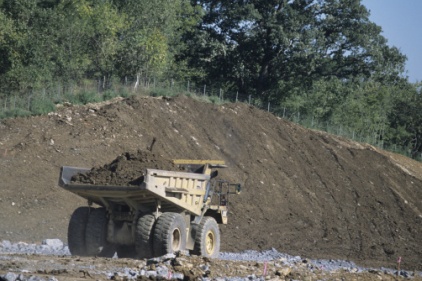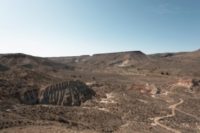Erionite: An emerging North American hazard

 Erionite is a naturally occurring mineral that belongs to a group of silicate minerals called zeolites. It is usually found in volcanic ash that has been altered by weathering and ground water. Like naturally occurring asbestos, deposits are present in many Western states).1 Erionite can occur in a fibrous form. Disturbance of this material can generate airborne fibers with physical properties and health effects similar to asbestos. For example, it has long been known that residents of some Turkish villages where erionite-containing rock was used to construct homes have a remarkably high risk for development of malignant mesothelioma.2
Erionite is a naturally occurring mineral that belongs to a group of silicate minerals called zeolites. It is usually found in volcanic ash that has been altered by weathering and ground water. Like naturally occurring asbestos, deposits are present in many Western states).1 Erionite can occur in a fibrous form. Disturbance of this material can generate airborne fibers with physical properties and health effects similar to asbestos. For example, it has long been known that residents of some Turkish villages where erionite-containing rock was used to construct homes have a remarkably high risk for development of malignant mesothelioma.2
Until recently, erionite was not generally considered to be a potential hazard in North America, in part because relatively little risk for exposure was seen. However, evidence has slowly accumulated linking exposure to erionite with serious adverse health effects in North America, and suggesting that some workers may have a greater potential for exposure than previously recognized.
The first North American with erionite-related lung disease was recognized in Utah and reported in 1981.3 He was a road construction worker who lived in an area rich in zeolite deposits. He had extensive parenchymal and pleural fibrosis and had a lung biopsy revealing the presence of both fibrous and nonfibrous particles which had compositions determined by energy-dispersive X-ray analysis to be consistent with erionite.
In 2008, a mesothelioma cluster was described in the vicinity of a small village in a zeolite-rich region of central Mexico.4 The same year, two additional cases were reported from a neighboring Mexican state.5 One of them underwent lung biopsy and examination of tissue showed a high burden of erionite.
In 2009, a mesothelioma case associated with pulmonary interstitial fibrosis, pleural plaque formation and substantial lung burden of erionite was documented in a man who had lived in Mexico and the United States.6
In 2011, the results of a study conducted in southwestern North Dakota were reported.7 The study was motivated by the realization that, since the 1980s, gravel pits had been excavated in areas containing erionite deposits and the gravel used to surface local roads and other areas. Ambient and activity-based sampling was performed and demonstrated the potential for airborne fiber exposures. Individuals with potentially high exposures were identified and underwent careful clinical evaluation. Two with histories of road maintenance work (one had also worked in a local gravel pit) were found with mild bilateral localized pleural changes with calcification and minimal unilateral and bilateral lower lobe interstitial changes that could only be seen by CT scan. Other than erionite, neither reported potentially causative exposures.
There are no regulatory or consensus standards or occupational exposure limits (OEL) for airborne erionite fibers. Development of a quantitative OEL awaits development of a standardized, validated exposure assessment method and quantitative evaluation of risks associated with given exposures. Still, The National Toxicology Program has designated erionite to be a known human carcinogen and a study by the U.S. Geological Survey found that erionite fibers from the Cappadocian region of Turkey, North Dakota, and Oregon were chemically and morphologically similar.8,9
Little is known about exposures currently experienced by U.S. workers. However, erionite-related disease has most often been reported in road construction and maintenance workers with potential occupational exposures to erionite-containing gravel used in road surfacing.
Also, one case had worked in an erionite-containing gravel pit (but had also been a road worker). Although it is reasonable to be concerned, erionite-related clinical disease has not yet been reported in other US workers engaged in activities that might crush erionite-containing rock or stir up dust in soils/gravel that contain erionite.
Erionite fibers only pose a hazard if they are disturbed and become airborne, and control recommendations should focus on reducing the potential for exposure to airborne erionite fibers. Activity-based breathing zone air sampling has confirmed that when gravels containing erionite are disturbed, erionite fibers can become airborne.10 Intensity of these exposures may vary due to a number of factors, including the weather conditions (damp vs. dry, windy vs. calm), the intensity with which erionite-containing materials are disturbed and the concentration of erionite in the gravels being disturbed. However, bulk gravel erionite concentrations alone are not a reliable predictor of air concentrations, as disturbance of gravels containing erionite in "trace" amounts (< 0.2%) can sometimes result in relatively high airborne fiber concentrations.
These data support the need to implement precautions to protect workers by limiting the generation and inhalation of dust known or thought to be contaminated with erionite. A reasonable approach based on current information would be to take precautions such as those described in existing guidance for working with asbestos (Occupational Safety and Health Administration [OSHA] 29 CFR 1910.1001). Existing recommendations for working in areas with naturally occurring asbestos may be particularly relevant to reducing outdoor occupational erionite exposures.11
Risk reduction recommendations to limit erionite exposures of workers who engage in activities that disturb erionite-containing gravel/soil or crush rocks that contain erionite can include:
• Training workers about the potential hazards of erionite and control methods for reducing the potential for exposure
• Knowing where erionite containing material is present and will be encountered prior to beginning any work
• Avoiding the use of erionite containing aggregate whenever possible
• Using wet methods to reduce dust generation for road and other work such as in quarries where erionite is present (e.g., when drilling rock, apply water through the drill stem to reduce airborne dust, or use a drill with a dust collection system)
• Limiting the number of workers who will be engaged in work with erionite
• Establishing decontamination protocols including change of clothing, showering before leaving the worksite, and appropriate cleaning/disposal of personal protective equipment
• Ensuring work clothing is not washed at home to prevent erionite fibers from being brought home on work clothes and boots
• Prohibiting dry sweeping, the use of leaf blowers, or the use of compressed air for cleaning
• Protecting employees with personal protective equipment, including respiratory protection. Note: An occupational safety and health professional should be consulted for specific guidance about the most appropriate personal protective equipment that should be used for the work being conducted.
• Prohibiting eating, drinking, or smoking in dusty work areas where erionite fibers may be airborne. Workers should move away from the work area for breaks and wash their hands and face before eating, drinking, or smoking.
• Establishing protocols for vehicle use on erionite containing roads (drive slowly, vents closed, windows up)
• Wet washing equipment and vehicle exteriors, and wet cleaning/High Efficiency Particulate Air (HEPA) filter vacuuming of vehicle interiors.
• Following Environmental Protection Agency (EPA) procedures for proper dispose of waste and debris that contains erionite.
• Limiting bystander exposure by preventing visitors and coworkers from standing in work areas where erionite fibers may become airborne.
Although much remains to be learned about erionite in the US, airborne occupational erionite fiber exposures should be considered at least as hazardous as asbestos fiber exposures and similar preventive measures used. We look forward to working with our scientific colleagues to stay informed about further occupational health data relating to erionite as more studies become available, and we invite you to consider what scientific and technical questions you would have about this emerging occupational health issue.
Works Cited
1. Sheppard R. Occurrences of erionite in sedimentary rocks of the western United States. Denver, CO: US Department of the Interior, US Geological Survey; 1996. Open File Report 96018.
2. Carbone M, Baris I, Bertino P, Brass B, Corertpay S, Dogan A, Gaudino G, Jube S, Kanodia S, Partridge C, Pass H, Rivera Z, Steele I, Tuncer M, Way S, Yang H, Miller A (2011). Erionite exposure in North Dakota and Turkish villages with mesothelioma. Proc Natl Acad Sci U S A 108(33):13618-13623.
3. Rom W, Casey K, Parry W, Mjaatvedt C, Moatamed F (1983). Health implications of natural fibrous zeolites in the intermountain west. Environ Res 30:1-8.
4. Ilgren EB, Ortega Brena M, Castro Larragoitia J, et al. A reconnaissance study of a potential emerging Mexican mesothelioma epidemic due to fibrous zeolite exposure. Indoor Built Environ. 2008;17:496515.
5. Ilgren EB, Pooley FD, Larragoitia JC, et al. First confirmed erionite related mesothelioma in North America. Indoor Built Environ. 2008;17:567568.
6. Kliment CR, Clemens K, Oury TD. North american erionite-associated mesothelioma with pleural plaques and pulmonary fibrosis: a case report. Int J Clin Exp Pathol. 2009;2(4):407-10. Epub 2008 Nov 25.
7. Ryan P, Dihle M, Griffin S, Partridge C, Hilbert T, Taylor R, Adjei S, Lockey J (2011). Erionite in road gravel associated with interstitial and pleural changes an occupational hazard in Western United States. J. Occup Environ Med 53(8): 892-898.
8. NTP-NIEHS. Report on carcinogens, twelfth edition (2011). Erionite. CAS No. 66733-21-9. [ntp.niehs.nih.gov/ntp/roc/twelfth/profiles/Erionite.pdf, accessed 11/4/11].
9. USGS (2010). Chemical and morphological comparison of erionite from Oregon, North Dakota, and Turkey. Prepared for the U.S. Environmental Protection Agency, Region 8. U.S. Department of the Interior, U.S. Geological Survey. Open-File Report 2010-1286.
10. EPA (2007) Analytical results report; Dunn County erionite, Killdeer, Dunn County, North Dakota. United States Environmental Protection Agency, Contract No. EP-W-05-050
11. ATSDR-CDC. Asbestos: for workers involved in activities that disturb soil or generate dust in areas with naturally occurring asbestos. [www.atsdr.cdc.gov/noa/docs/Asbestos-workers.pdf, accessed 10/22/2011].
Looking for a reprint of this article?
From high-res PDFs to custom plaques, order your copy today!





